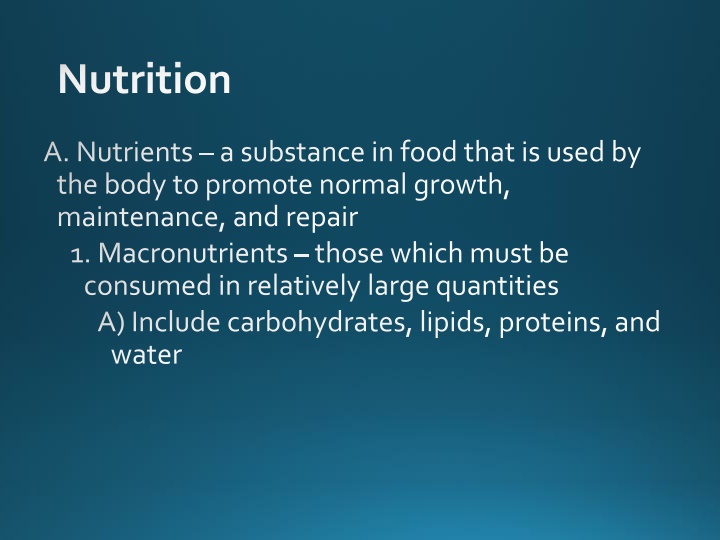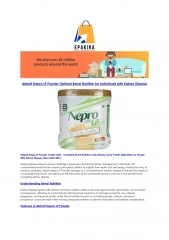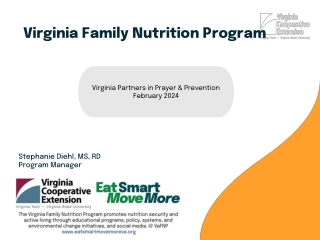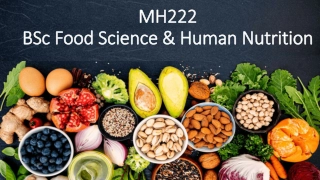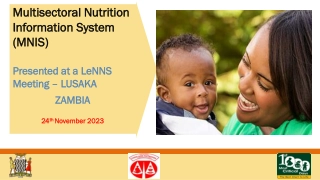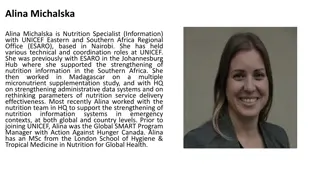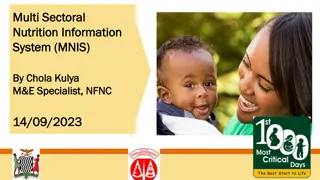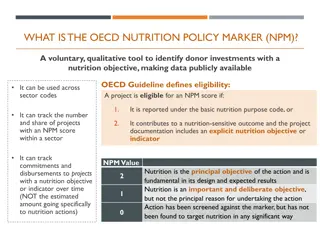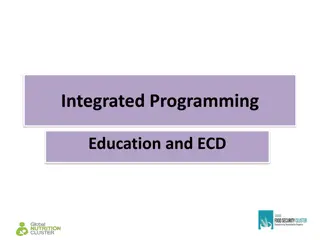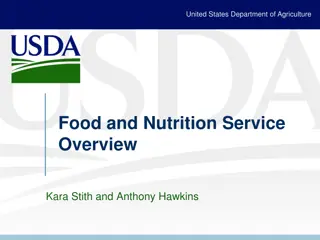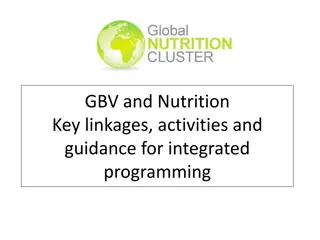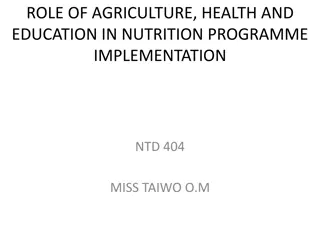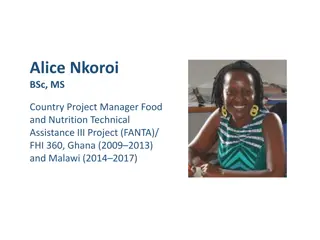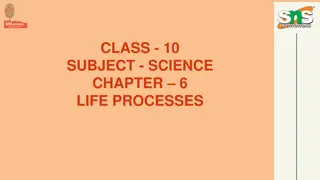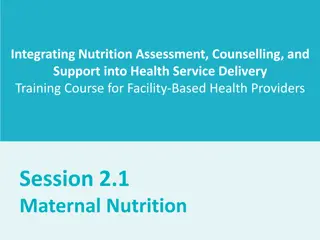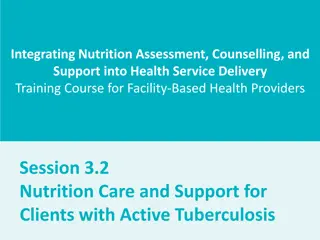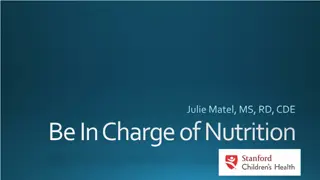Nutrition
Nutrients in food play a vital role in promoting growth, maintenance, and repair in the body. Learn about macronutrients like carbohydrates, lipids, proteins, and water, as well as micronutrients such as vitamins and minerals. Essential nutrients that cannot be produced by the body must be obtained through the diet. Explore sources, functions, and locations of macronutrients in the body and understand the impact of problems related to excess or deficits. Discover the importance of lipids in protecting organs, providing energy, and supporting various bodily functions.
Download Presentation

Please find below an Image/Link to download the presentation.
The content on the website is provided AS IS for your information and personal use only. It may not be sold, licensed, or shared on other websites without obtaining consent from the author.If you encounter any issues during the download, it is possible that the publisher has removed the file from their server.
You are allowed to download the files provided on this website for personal or commercial use, subject to the condition that they are used lawfully. All files are the property of their respective owners.
The content on the website is provided AS IS for your information and personal use only. It may not be sold, licensed, or shared on other websites without obtaining consent from the author.
E N D
Presentation Transcript
Nutrition A. Nutrients a substance in food that is used by the body to promote normal growth, maintenance, and repair 1. Macronutrients those which must be consumed in relatively large quantities A) Include carbohydrates, lipids, proteins, and water
Nutrition 2. Micronutrients those which are required in small quantities A) Include vitamins and minerals 3. Essential nutrients any nutrient that cannot be made by the body and must be provided by the diet A) Include minerals, most vitamins, 8-9 amino acids and 1-2 fatty acids
Nutrition B. Summary of Macronutrients 1. Carbohydrates A) Sources 1) Complex carbohydrates (starches) bread, cereal, flour, pasta, nuts, rice, and potatoes 2) Simple carbohydrates (sugars) carbonated drinks, candy, fruits, and yogurts 3) Both complex and simple pastries
Nutrition B) Uses in the body 1) Short-term energy source used to make ATP 2) Used to synthesize nucleic acids, glycolipids, glycoproteins, ATP, cAMPand many cell surface receptors C) Locations in the body 1) Adults generally have about 375-475g a) ~325g = muscle glycogen
Nutrition b) 90-100g = liver glycogen c) 15-25g = blood glucose i) Blood glucose is usually measured in mg/dl with normal levels in the low to mid 100 s D) Problems 1) Excess obesity, cavities & upset stomach 2) Deficits tissue wasting & metabolic acidosis
Nutrition 2. Lipids A) Sources 1) Saturated fatty acids meat, egg yolks, and dairy products 2) Unsaturated fatty acids nuts, seeds, and most vegetable oils 3) Essential fatty acids corn, cottonseed & soy oils, and vegetable shortening 4) Cholesterol organ meats and egg yolks
Nutrition B) Uses in the body 1) Protect and cushion organs 2) Insulate body and organs 3) Long-term energy source; most calories (energy) per gram of all nutrients 4) Stabilize cell membranes 5) Precursor for bile salts, steroid hormones, and vitamin D 6) Necessary for fat-soluble vitamin absorption
Nutrition 7) Thromboplastin (blood clotting factor), prostaglandins and eicosanoids are all derived from lipids C) Serum lipoproteins 1) Tiny droplets with a core of cholesterol and triglycerides surrounded by a protein and phospholipid coating 2) Allows lipids to be transported in the blood to be recognized by the body s cells
Nutrition 3) 4 categories a) Chylomicrons i) Absorbed in the digestive system and ultimately stored in adipocytes as triglycerides b) High-density lipoproteins (HDLs) i) Formation primarily occurs in the liver ii) Act as a vehicle to remove excess cholesterol from the body
Nutrition c) Low-density lipoproteins (LDLs) i) Mostly cholesterol ii) Transport cholesterol to cells that require it d) Very low-density lipoproteins (VLDLs) i) Produced in the liver ii) Transport lipids around the body for use or storage iii) Converted to LDLs
Nutrition 4) Desirable Cholesterol Levels a) Total cholesterol = <200mg/dl b) HDL = 40-56mg/dl for males & 50-60mg/dl for females c) LDL = <100mg/dl
Nutrition D) Problems 1) Excess obesity, cardiovascular disease, & Type 2 diabetes 2) Deficits weight loss, poor growth, skin lesions, increased risk of strokes, & slower metabolic rate
Nutrition 3. Proteins A) Sources 1) Complete proteins egg whites, milk, meat, fish, and poultry 2) Incomplete proteins legumes, nuts, seeds, vegetables, grains, and cereals B) Uses in the body 1) Structural proteins such as keratin, collagen, elastin, and muscle fibers
Nutrition 2) Functional proteins such as enzymes, hemoglobin, hormones & receptors, and membrane proteins C) Problems 1) Excess obesity and kidney & liver problems 2) Deficits weight loss and tissue wasting, growth retardation, anemia, edema, premature birth & miscarriage
Nutrition 4. Vitamins A) Fat soluble vitamins 1) VitaminA a) Antioxidant; requiredfor skin & mucus structureand normal bone development b) Found in greenleafy vegetables, eggyolk, liver, and fortifiedmilk & margarine
Nutrition 2) Vitamin D a) IncreasesbloodCa++levels b) Producedin the skin exposedto UV light, also found in eggyolk and fortified milk
Nutrition 3) Vitamin E a) Antioxidant thatpreventsoxidation of fatty acids preventingdamage to cell membranes by freeradicals b) Found in vegetableoils, nuts, whole grains, and darkleafy vegetables
Nutrition 4) Vitamin K a) Essential in clottingproteinformation b) Found in green leafy vegetables, broccoli, cabbage, cauliflower, and pork liver c) Is also produced by bacteria normally present in the large intestine
Nutrition B) Water soluble vitamins 1) Vitamin C (ascorbic acid) a) Antioxidant, necessary for the formation of most connective tissues and the conversion of cholesterol to bile salts, aids iron absorption b) Found in fruits (especially citrus) and vegetables
Nutrition 2) B-complex Vitamins a) Thiamine (B1) helps convert pyruvic acid to acetyl CoA and is necessary for the synthesis of ACh; found in lean meats, eggs, and green leafy vegetables b) Riboflavin (B2) acts as FAD; found in egg whites, fish, and milk c) Niacin (B3) acts as NAD; found in poultry, fish, and meat
Nutrition d) B6 necessary for amino acid metabolism and the formation of antibodies and hormones; found in meat, poultry, fish, whole grains, and bananas e) Folic acid (B9) essential for RBC formation and embryonic neural tube development; found in liver, orange juice, deep-green vegetables, lean beef, eggs, and whole grains
Nutrition f) B12 necessary for RBC production and proper metabolism in the GI tract, nervous system, and bone marrow; found in liver, meat, poultry, and eggs
Nutrition 5. Minerals A) Major minerals 1) Calcium (Ca) necessary for bone density, impulse conduction and muscle contraction 2) Phosphorus (P) required for the production of nucleic acids, proteins, and ATP
Nutrition 3) Potassium (K) necessary for impulse conduction and muscle contraction 4) Sulfur (S) a component of some amino acids & vitamins; vital for tertiary protein structure 5) Sodium (Na) necessary for maintaining osmotic pressure, impulse conduction, muscle contraction, and acid-base balance
Nutrition 6) Chloride (Cl) required for CO2transport and HCl production 7) Magnesium (Mg) a coenzyme (NAD & FAD) component
Nutrition B) Trace minerals 1) Iron (Fe) component of hemoglobin 2) Manganese (Mn) required for the synthesis of fatty acids, cholesterol, urea, & hemoglobin 3) Copper (Cu) required for the production of hemoglobin, melanin, and myelin
Nutrition 4) Iodine (I) required for the formation of thyroid hormones 5) Zinc (Zn) enzyme/protein component, required for normal growth, wound healing, taste, smell, and sperm production
Nutrition C. Food Intake Regulation 1. Hypothalamus hunger center A) Releases a number of chemicals 1) Orexins appetite enhancers 2) Neuropeptide Y increases cravings for carbs 3) Galanin increases cravings for fats 4) Serotonin promotes feeling of fullness & satisfaction
Nutrition B) Also binds to chemicals 1) Leptin a) Released from fat tissue in response to increased fat deposits b) Inhibits hunger and increases metabolism 2) Ghrelin a) Released from cells in the stomach lining b) Stimulates hunger
Metabolism A. Metabolism sum of all the chemical processes in the body B. Types of Metabolic Reactions 1. Anabolic reactions energy-requiring reactions that build organic compounds 2. Catabolic reactions energy-releasing reactions that break organic compounds and often generate ATP
Metabolism 3. Oxidation reaction any reaction where a molecule gains oxygen or loses a hydrogen 4. Reduction reaction any reaction where a molecule loses oxygen or gains a hydrogen A) Oxidation and Reduction (Redox) reactions are always coupled
Metabolism C. Carbohydrate Metabolism 1. Glucose catabolism is the breakdown of CHO to release energy (cellular respiration) A) It is accomplished in four steps: Glycolysis, Pre-Krebs, the Krebs cycle, and the Electron Transport Chain 2. Glycolysis sugar splitting occurs in the cytoplasm of the cell and does not require oxygen
Metabolism A) 1 glucose molecule is broken down into 2 molecules of pyruvic acid B) 4 ATP are produced during the process. However, 2 ATP are used during the process. Therefore, the net result is only 2 ATP for glycolysis C) 2 H atoms are removed (oxidation) and are picked up by 2 NAD+to form 2 molecules of NADH (reduction)
Metabolism D) The fate of pyruvic acid depends on the oxygen availability 1) No oxygen present acidic fermentation a) H from NADH is transferred to pyruvic acid resulting in lactic acid 2) Oxygen present Krebs cycle
Metabolism 3. Pre-Krebs A) As pyruvic acid enters the mitochondria, a C and H are removed and coenzyme A is added resulting in 2 molecules of acetyl CoA B) The 2 carbon atoms that were removed bind with O2forming 2 molecules of CO2
Metabolism C) The 2 H atoms that were removed bind with NAD+forming 2 molecules of NADH D) No ATP are formed during this step 4. Krebs Cycle occurs in the matrix of the mitochondria A) Acetyl CoA enters the Krebs cycle where it combines with oxaloacetic acid to create citric acid
Metabolism B) As the cycle moves around, citric acid is rearranged to produce different intermediate molecules called keto-acids C) At the end of the cycle, the resulting molecule is oxaloacetic acid which is now available to attach to another acetyl CoA D) Totals for the Krebs cycle 1) 4 C atoms are removed and combine with O2 forming 4 molecules of CO2
Metabolism 2) 10 H atoms are removed and combine with NAD+(6) or FAD (4) resulting in 6 NADH and 2 FADH2 3) 2 molecules of ATP are synthesized per cycle F) All NADH (10; 2 from glycolysis, 2 from pre- Krebs, 6 from Krebs) & FADH2(2 from Krebs) produced up to this point will enter the electron transport chain
Metabolism 5. Electron Transport Chain (ETC) occurs on the cristaeof the mitochondria A) Involves membrane proteins acting as H+ pumps that will release energy as an electron is transferred from one to another B) NADH and FADH2drop off their hydrogen atoms to the chain of electron acceptors (pumps) C) As the H are dropped off they lose their electrons which travel down the chain (from one pump to the next)
Metabolism D) The energy from the electrons is used to pump H+into the intramenbranous space, creating a H+ gradient 1) The electrons ultimately end up forming the bond between O and H resulting in the eventual formation of H2O a) Oxygen is considered the final electron acceptor for cellular (aerobic) respiration F) Intramembranous H+then moves through ATPsynthasecreating the energy to combine ADP + P resulting in ATP
Metabolism 1) Each NADH stores enough energy to create 2.5 molecules of ATP 2) Each FADH2stores enough energy to create 1.5 molecules of ATP G) Results in the production of 28 ATP; therefore the entire process from glycolysis thru ETC yields a net of 32 ATP
Metabolism 6. Carbohydrate Anabolism A) When cellular ATP reserves are high or when glucose is in excess, glucose has to be stored 1) Glucose catabolism is inhibited 2) Glucose conversion to glycogen (glycogenesis) or to fat (lipogenesis) is stimulated
Metabolism B) When ATP or glucose levels drop the body can then convert glycogen back to glucose 1) Glycogenolysis production of glucose from glycogen 2) Gluconeogenesis formation of glucose from non-carbohydrate molecules (such as fat and protein) 3) Both processes occur in the liver
Metabolism D. Lipid Metabolism 1. The end products of lipid digestion (lipolysis) and cholesterol digestion are transported in the blood as chylomicrons 2. The glycerol is converted to glucose (which enters into glycolysis) or G3P (which eventually enters the Krebs cycle)
Metabolism 3. The fatty acids are broken down into fragments which bind to coenzyme A creating acetyl CoA which enter the Krebs cycle 4. Dietary fats not needed for energy or structural materials are stored in adipose tissue
Metabolism 5. When carbohydrates are scarce, the breakdown of fats for energy results in the formation of keto-acids (ketones) which can be deadly in high amounts because they lower the blood pH resulting in a condition known as ketoacidosis.
Metabolism E. Protein Metabolism 1. To be used for energy, amino acids are converted into pyruvic acid or keto-acids that can then enter into Krebs A) This process involves the following events:
Metabolism 1) One of any number of amino acids transfers their amine group to -ketoglutaricacid resulting in the formation of glutamic acid a) This process is known as transamination 2) In the liver, the amine group from glutamic acid is removed in the form of ammonia (NH3) and combined with CO2to form urea a) This process is known as deamination
Metabolism b) The urea is then excreted into the blood where it is filtered out by the kidneys and released in urine c) Deaminated amino acids may also be converted to fatty acids or glucose 2. Protein anabolism requires essential amino acids A) If any of them are lacking, amino acids are used as energy fuels
Metabolism F. Role of the Liver in Metabolism 1. The liver is the body s main metabolic organ and it plays a crucial role in processing or storing virtually every nutrient group 2. The liver has several metabolic functions: A) Packages fatty acids to forms that can be stored or transported B) Synthesizes plasma proteins
